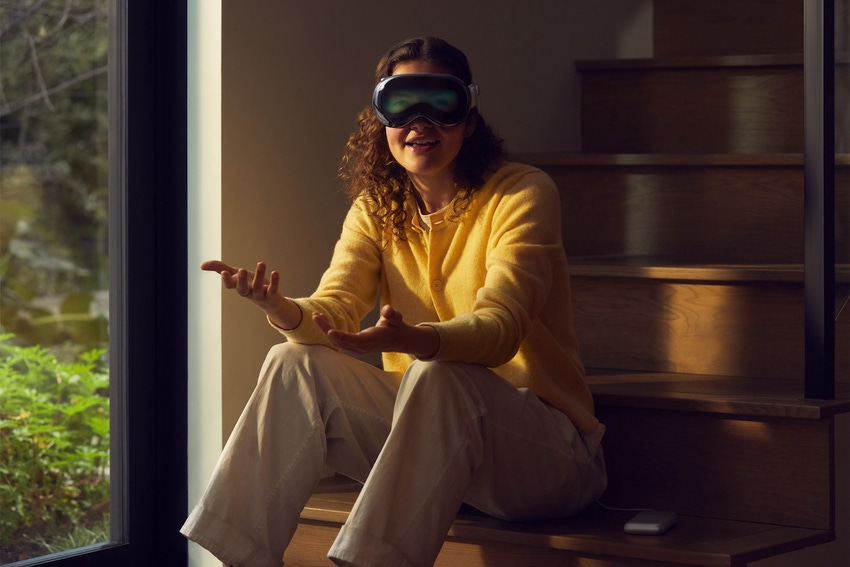Apple places next big bet on a different kind of reality
The iPhone maker signals its next big move as it unveils the Vision Pro mixed reality headset, although the new device comes with a hefty price tag.

The hype around Apple's latest maneuver in the consumer electronics space certainly ensured that expectations were high ahead of the iPhone maker's Worldwide Developers Conference (WWDC) last night/yesterday morning depending on where you are based.
For some, the hype seemed commensurate with what was announced: a mixed reality headset called the Apple Vision Pro that is due to be launched in the US in early 2024 with a somewhat hefty price tag of $3,499. Other announcements included a preview of the new iOS 17 operating system to be launched this autumn, a 15-inch MacBook Air with the M2 chip, Mac Studio with M2 Max and M2 Ultra, and Mac Pro with M2 Ultra.
According to Paolo Pescatore, analyst at PP Foresight, Vision Pro was "undoubtedly the star of the show."
"Make no mistake, this is a wow moment for the company and the consumer electronics industry. Today marks Apple's biggest device launch in a while – since the Watch – that will change the way we interact and engage with content forever," Pescatore enthused.
A more waspish response came from analysts at KeyBanc, which said the hype leading into the event "felt well overdone, setting up for a prime sell-the-news event in trading today."
What Apple did next
Apple Vision Pro was clearly the much-anticipated main event at WWDC. Apple describes it as a "spatial computer" that "blends digital content with the physical world, while allowing users to stay present and connected to others."
Notably, the device also features a new operating system called visionOS, which Apple trumpeted as the "world's first spatial operating system." You can find reports aplenty about the headset itself, such as at Tom's Guide here. For us, a key question is: What does the arrival of this new type of device from such a market disruptor as Apple mean for telecom operators and the wider ecosystem?
In KeyBanc's view, Vision Pro does not look set to replace the iPhone anytime soon, for example, given its battery life and network limitations, among other factors. "It's far too early to say where this product can go. While the technological capabilities look great, the product looks more like a replacement of TVs and monitors, and we wonder what network characteristics are needed to support the use," the analysts commented.
Pescatore also warns that no comparisons should be made with previous devices, nor pricing or sales volumes. "This product is unlikely to repeat the volumes seen with other Apple devices in their first years post-launch. Having said this, Apple excels in marketing, is a trusted brand and will eloquently articulate the merits of the platform and new device to all users," he added.
Pescatore also highlights the fact that the device will be launched as more operators launch 5G standalone (SA) and other new network features that will help to enhance the mixed reality experience.
To be sure, operators regularly cite AR, VR and XR as opportunities for future 5G SA networks, and Pescatore sees the new device as important for telcos "in their quest to bundle more devices, services and subscriptions and drive higher volumes and revenue."
A generally held view is that Vision Pro is the biggest gamble on a product yet from Apple CEO Tim Cook.
"This is the start of a long journey," said Pescatore. "Apple has grand plans to revolutionize this segment as it has done with the iPhone; remember this is its first foray. The hardware, services and experiences will evolve considerably over time to include other devices."
Pescatore noted that it will take time for this category to stand on its own, as other manufacturers to have entered the VR and AR space will no doubt attest. "It is apparent that for now, it's about Apple putting a stake in the ground, providing developers with all the tools to create next-generation experiences. This in turn will generate user demand ahead of bigger moves in the future," he said.
AI: Missing in action?
Ahead of WWDC analyst Richard Windsor posted a blog on his Radio Free Mobile site that was particularly critical of Apple's lack of progress on artificial intelligence (AI).
"Most likely to be missing will be generative AI where as far as I can tell, Apple is nowhere," Windsor said. "Siri remains as awful as ever and is now hopelessly outclassed by any system that is based on a large language model."
Pescatore had a somewhat different view, praising Apple for "not overplaying the role of AI across its device portfolio, platform and services offerings," unlike some of its rivals.
"Apple is quietly stepping up its capabilities in AI. Most, if not all new features are powered by AI. We should not underestimate the sheer intelligence behind the scenes to optimize experiences for users," he added.
Apple seems to prefer to use the term machine learning rather than AI, outlining a number of new features for developers such as machine learning APIs. Features supported by AI or ML include Persona on the Vision Pro, which uses built-in cameras to scan a user's face and create a lifelike, interactive "digital representation" of the wearer "created using Apple's most advanced ML techniques."
Others are Live Voicemail, which Apple said is powered by its neural engine and "occurs entirely on device … this information is not shared with Apple;" improved dictation with the new iOS 17; FaceTime presenter mode powered by the neural engine; the Apple Journal app supported by ML; Personalized Volume; and photo recognition for cats and dogs.
No doubt to the delight of iPhone users everywhere, iOS 17 also offers a new autocorrect feature that includes a "transformer model" to improve word prediction capabilities. Apparently, this means that one well-known word will no longer be automatically changed to "ducking."
Related posts:
— Anne Morris, contributing editor, special to Light Reading
About the Author(s)
You May Also Like




_International_Software_Products.jpeg?width=300&auto=webp&quality=80&disable=upscale)







